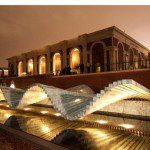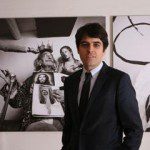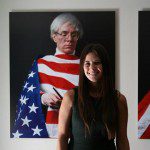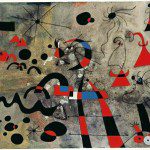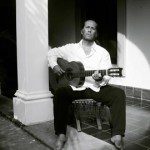Arts and Culture, the Spanish Way
By • May 3, 2012 0 2326

What do people outside of Spain think of when they think of Spanish culture?
For certain, Don Quixote, the gallant knight who tilts at windmills, the singular creation of Cervantes, from Spain’s golden age. Flamenco, for sure. In the passionate sounds of dancing and guitar, it’s as if the soul of a nation were revealed in its music and embrace in its dance.
There are giants of art—the great painters who pioneered and pushed forward the form from El Greco to Goya to Picasso to Miro, comprising a pantheon all their own, always looking into the future, even as they become legends of the past.
If you are any kind of student of film as art than it is hard to forget Buñuel and Almodóvar, both revolutionary and provoking in their own ways, the one building a bridge to the works of the other.
But what about the great flamenco singers, and the Flamenco Project? What about the work of the great Spanish photojournalist Jordi Socias? Or the startling work of Albert Schommer? Have you ever heard of Pacio Lucia, Spain’s great contemporary composer and musician? Or Don Quixote re-appearing as a children’s hero? Have you been to Gala Hispanic Theater or heard of Carmen Cortes, Rafaela Carrasco, Olga Pericet?
Do you know about “We Made This: Spanish Post Digital Creation Culture”?
Somewhere along the way, Washingtonians have probably encountered various aspects of Spanish culture like some of the aforementioned events, projects and artists over the past few years, especially since the spring of 2011, when an ubiquitous logo and emblem started to make its mark in the city.
“Spain Arts & Culture,” a brand in a logo of what seems to be swirling stone, takes you into the rest of the story. And the color red, as in Spain Red, the Spanish Cultural Network, takes you deeper still and the rest of the way.
“Spain Arts & Culture” is an expression of Spanish culture, a way to promote all aspects of Spanish culture on a broad, widespread scale throughout the United States in key cities on a biannual basis, singling out, marketing and promoting Spanish cultural events, exhibitions, performances and projects to the public. As a full-scale effort, “Spain Arts & Culture,” and its social network companion Spain Red, is singularly modern in form, keenly conscious of the opportunities for networking, marketing and promotion provided by the digital age.
“The key elements of this effort are the importance of branding and design, the pre-eminence of online communication and marketing and the important value we place on our partnerships with local institutions,” said Guillermo Corral, the Cultural Counselor and Head of the Cultural Office of the Embassy of Spain in Washington. Corral is the de facto man in charge of this effort, a veteran cultural diplomat who was appointed the first Director of the Directorate General for Cultural Policy and Cultural Industries within the Spanish Ministry of Culture in 2008, a position which he held until coming to Washington, and one that gives him the cache, experience and gravitas to speak with authority and act with authority on the subject of Spanish culture.
The effort across the United States, involving dozens of cities, is to promote Spanish culture in such a way that it combines the old and new, the traditional and the cutting-edge products of the culture. Through the form of every available marketing tool — including, so far, three edgy, splashy and comprehensive catalogues — the program embraces culture in the largest senses of the word. It includes Spanish urban culture, design, architecture, fine arts, film, Spanish heritage, performing arts and literature as well as food and fashion components. This spring and summer season involves cities allacross the United States, spearheaded through Spanish consulates, or cultural organizations, among them Washington, D.C., where the initial effort had its origins. New York, Dallas and Houston, Los Angeles, Puerto Rico, Miami, Seattle, San Francisco, Boston and Chicago are also participating.
“I believe firmly in forming partnership through all available means,” Coral said. In this sense, he serves as coordinator, facilitator and creative force for promoting Spanish culture in the United States and especially here in Washington. “This is a very urban, international city, among many of its aspects. The dining opportunities, for instance, offer so many world flavors. The cultural opportunities are enormous here, very modern, but also respectful of tradition. Spanish culture, to me, is that best of combinations. It is a country that was, in its days of empire and exploration, very much in the position of the United States today. We live in a different world, of course, with great economic difficulties, but that makes it both a reward and a challenge to promote our culture for me.”
Corral, 40, married with two young children, comes from Valladolid, a city of 500,000 near Madrid. “It’s small, by some standards,” he said. “I had a very good upbringing, but I left as soon as I could. Spain is a country of big cities, big ideas. It’s building very much a new culture for a new world, and I think that has been a tradition, this pushing the new forward.”
If you look at some of the spring-summer offerings in Washington alone, you can get a feel of that ebb and flow, of old and new, tradition and progression. There’s the ongoing comprehensive and revealing exhibition of Picasso’s drawings now at the National Gallery of Art, which will soon be joined by “Joan Miro: The Ladder of Escape,” another major exhibition of 120 paintings.
There is Paco De Lucia, a renowned composer and performer, who will be showing up at the Music Center at Strathmore to perform “En Vivo” on April 18.
“For myself, I think I’m partial to new things, new ways of doing things. It’s exciting to be working on some of the things we are doing,” Corral said. “This time, I am attracted to ‘We Made This: Spanish Post-Digital Creation Culture.’ This is a huge design festival of the work of younger Spanish artists working in the digital field, exploring endless opportunities and vistas.”
The show will be at the Hirshhorn Museum and Sculpture Garden this June.
“We work with many of the local institutions,” he said. “It’s a must and a hallmark of what we do. For instance, there is an exhibition of the works of Spanish-American artists working in New York, showing at the Art Museum of the Americas.”
It’s when you look at the Washington venues for “Spain Arts & Culture” that you get a sense of the ambition, the fertile variety and scope of the project. During spring and summer, there’s Teatro de La Luna’s annual Theatre Festival, which will feature a Madrid Theater company, as well as a children’s version of “Don Quixote” at Gala Hispanic Theatre. A major Flamenco Festival is just now concluding, focusing on the critical singing aspect of the flamenco’s form. An entry in the upcoming Environmental Film Festival is also part of the project, along with a Spanish entry in the D.C. Street Festival and a performance in May at the Millennium Stage at the Kennedy Center.
In May there will be a Spanish entry in the Kids World Cinema Festival, and in June we can expect to see the Sounds of Catalonia at the National Gallery of Art and the Kreeger Museum. Entries in the 2012 Silverdocs Film Festival at the AFI Silver Theatre in Silver Spring and the 2012 Euro Asia Shorts festival, will also be on view through the month of June at embassies throughout Washington.
The works of Schommer, a dramatic portrait photographer of considerable note, are now on display in the Embassy of Spain.
“We launched the ‘Spain, Arts & Culture’ program about a year ago,” Corral said. “It was the logical outcome of the ‘Preview Spain, Arts & Culture’ programs that were started by my predecessors. It incorporates their efforts and some of my own ideas about how best to undertake cultural promotion in these times.
“I have been impressed with so many of the people I have been working with in the city,” he said. “There’s the entire Smithsonian Institution, there’s the National Gallery of Art, there’s Jack Rasmussen at the Katzen Center at American University, Paul Emerson, Theo Adamstein from Photoweek DC, and many, many more. Of course, the really amazing man is Jose Andres, who has done so much to promote Spanish food in this country.”
The international community as a whole is an undeniably, but often forgotten, cultural presence in the Washington community. Spain and Guillermo Corral with the “Spain Arts & Culture” program may be showing the way toward embracing the onrushing future as a way of promoting culture.
- Jimena Paz and Guillermo Corral | Katherine Agurcia
- Yelp

